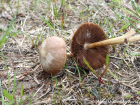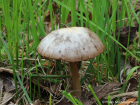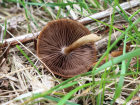Cap starts as a bell or cone shape, but later expands to a broad convex form. It is hygrophanous, appearing medium to dark brown when wet and drying from the centre outward to a creamy-beige colour. The flesh is buff brown and thin and unchanging when sliced. Gills at first pallid brown, becoming mottled darker and finally chocolate-brown, narrowly attached to the stem and crowded. Stem lighter in colour compared to the cap, with a cream hue that appears flushed with mid-brown towards the base. It has a cylindrical shape and a fine fibrillose texture. There is no ring present on the stem. The basal mycelium is white. Spore print dark brown.
Microscopic Features: The spores are lemon-shaped and have a roughened surface. They have a size range of 11-18 x 6-9µm and feature a germ pore.
Synonyms: Panaeolina foenesecii is a synonym.
Panaeolina foenisecii on the www.first-nature.com web site.
Panaeolus foenisecii on the MushroomExpert.Com web site.
Many mushrooms are poisonous, and some can be lethally toxic. Distinguishing between edible and poisonous mushrooms can be very challenging. Therefore, we strongly advise against consuming wild mushrooms. This website does not contain any information about the edibility or toxicity of mushrooms.
Although efforts have been made to ensure accuracy on this website, the information may contain errors and omissions. Therefore, all content provided is for educational and informational purposes only and should not be relied upon or used as a basis for consuming any plants or mushrooms.
External links are provided for reference only. We do not endorse or take responsibility for the content, advice, or products found on these sites or in any advertisements shown on this website.



